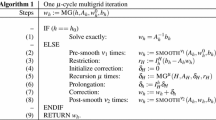Abstract
A class of nonlinear elliptic optimal control problems with mixed control-state constraints arising, e.g., in Lavrentiev-type regularized state constrained optimal control is considered. Based on its first order necessary optimality conditions, a semismooth Newton method is proposed and its fast local convergence in function space as well as a mesh-independence principle for appropriate discretizations are proved. The paper ends by a numerical verification of the theoretical results including a study of the algorithm in the case of vanishing Lavrentiev-parameter. The latter process is realized numerically by a combination of a nested iteration concept and an extrapolation technique for the state with respect to the Lavrentiev-parameter.
Similar content being viewed by others
References
Alibert J.-J. and Raymond J.-P. (1998). A Lagrange multiplier theorem for control problems with state constraints. Numer. Funct. Anal. Optim. 19(7–8): 697–704
Allgower E.L., Böhmer K., Potra F.A. and Rheinboldt W.C. (1986). A mesh-independence principle for operator equations and their discretizations. SIAM J. Numer. Anal. 23(1): 160–169
Alt W. (2001). Mesh-independence of the Lagrange–Newton method for nonlinear optimal control problems and their discretizations (Optimization with data perturbations, II). Ann. Oper. Res., 101: 101–117
Arada N., Casas E. and Tröltzsch F. (2002). Error estimates for the numerical approximation of a semilinear elliptic control problem. Comput. Optim. Appl. 23: 201–229
Bergounioux M. and Kunisch K. (2002). Primal–dual active set strategy for state-constrained optimal control problems. Comput. Optim. Appl. 22: 193–224
Casas E. (1986). Control of an elliptic problem with pointwise state constraints. SIAM J. Control Optim. 24: 1309–1318
Casas E. (1993). Boundary control of semilinear elliptic equations with pointwise state constraints. SIAM J. Control Optim. 31: 993–1006
Casas E. and Tröltzsch F. (1999). Second-order necessary optimality conditions for some state- constrained control problems of semilinear elliptic equations. Appl. Math. Optim. 39(2): 211–227
Casas E. and Tröltzsch F. (2002). Error estimates for the finite-element approximation of a semilinear elliptic control problem. Control Cybern. 31: 695–712
Casas E., Tröltzsch F. and Unger A. (2000). Second order sufficient optimality conditions for some state-constrained control problems of semilinear elliptic equations. SIAM J. Control Optim. 38(5): 1369–1391 (electronic)
Chen X., Nashed Z. and Qi L. (2000). Smoothing methods and semismooth methods for nondifferentiable operator equations. SIAM J. Numer. Anal. 38(4): 1200–1216 (electronic)
Deuflhard P. and Potra F.A. (1992). Asymptotic mesh independence of Newton–Galerkin methods via a refined Mysovskiĭ theorem. SIAM J. Numer. Anal. 29(5): 1395–1412
Dontchev A.L., Hager W.W. and Veliov V.M. (2000). Uniform convergence and mesh independence of Newton’s method for discretized variational problems. SIAM J. Control Optim. 39(3): 961–980 (electronic)
Facchinei, F., Pang, J.-S.: Finite-dimensional variational inequalities and complementarity problems, vol. II. Springer Series in Operations Research. Springer, New York (2003)
Hackbusch W. (1985). Multigrid methods and applications, vol. 4. Springer Series in Computational Mathematics. Springer, Berlin
Hintermüller, M.: Mesh-independence and fast local convergence of a primal–dual active set method for mixed control-state constrained elliptic control problems. ANZIAM J. (2007) (to appear)
Hintermüller M., Ito K. and Kunisch K. (2003). The primal–dual active set strategy as a semismooth newton method. SIAM J. Optim. 13: 865–888
Hintermüller M. and Kunisch K. (2006). Feasible and non-interior path-following in constrained minimization with low multiplier regularity. SIAM J. Control Optim. 45: 1198–1221
Hintermüller, M., Ring, W.: A level set approach for the solution of a state constrained optimal control problem. Num. Math. (2004)
Hintermüller M. and Ulbrich M. (2004). A mesh independence result for semismooth Newton methods. Math. Program. 101: 151–184
Ioffe A.D. (1979). Necessary and sufficient conditions for a local minimum. III. Second order conditions and augmented duality. SIAM J. Control Optim. 17(2): 266–288
Kummer B. (2000). Generalized Newton and NCP methods: convergence, regularity, actions. Discuss. Math. Diff. Incl. 20: 209–244
Lions, J.-L.: Some aspects of the optimal control of distributed parameter systems. Society for Industrial and Applied Mathematics, Philadelphia. Conference Board of the Mathematical Sciences Regional Conference Series in Applied Mathematics, No. 6. (1972)
Meyer C., Rösch A. and Tröltzsch F. (2006). Optimal control problems of PDEs with regularized pointwise state constraints. Comput. Optim. Appl. 33: 209–228
Prüfert, U., Tröltzsch, F., Weiser, M.: The convergence of an interior point method for an elliptic control problem with mixed control-state constraints. Comput. Optim. Appl. (to appear)
Rösch, A., Tröltzsch, F.: Existence of regular Lagrange multipliers for a nonlinear elliptic optimal control problem with pointwise control-state constraints (Submitted)
Tröltzsch F. (2005). Optimale Steuerung partieller Differentialgleichungen. Vieweg, Wiesbaden
Tröltzsch F. (2005). Regular Lagrange multipliers for control problems with mixed pointwise control-state constraints. SIAM J. Optim. 15: 616–634
Weiser M., Schiela A. and Deuflhard P. (2005). Asymptotic mesh independence of Newton’s method revisited. SIAM J. Numer. Anal. 42(5): 1830–1845 (electronic)
Wright S.J. (1997). Primal–dual Interior-Point Methods. Society for Industrial and Applied Mathematics (SIAM), Philadelphia
Author information
Authors and Affiliations
Corresponding author
Additional information
M. Hintermüller acknowledges support by the Austrian Science Fund FWF under START-program Y305 “Interfaces and Free Boundaries”.
F. Tröltzsch and I. Yousept acknowledge support through DFG Research Center “Mathematics for Key Technologies” (FZT 86) in Berlin.
Rights and permissions
About this article
Cite this article
Hintermüller, M., Tröltzsch, F. & Yousept, I. Mesh-independence of semismooth Newton methods for Lavrentiev-regularized state constrained nonlinear optimal control problems. Numer. Math. 108, 571–603 (2008). https://doi.org/10.1007/s00211-007-0134-6
Received:
Revised:
Published:
Issue Date:
DOI: https://doi.org/10.1007/s00211-007-0134-6




